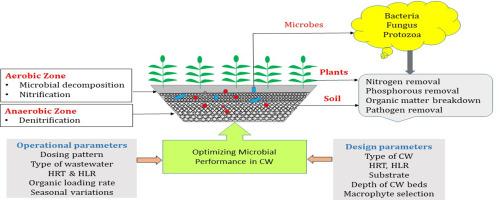Microbiological dimensions and functions in constructed wetlands: A review
IF 4.8
Q1 MICROBIOLOGY
引用次数: 0
Abstract
Constructed wetlands (CWs) have emerged as robust alternatives to traditional wastewater treatment technologies. The efficacy of CWs centers on the intricate interplay of factors, including plant species, substrate attributes, soil conditions, microbial consortia, and operational variables. Microorganisms, the cornerstone of CWs, have a significant influence on mineralization and pollutant mitigation processes. Microbial assemblies within CWs exhibit dynamic responses by adapting novel mechanisms. Here, Proteobacteria possess the ability to efficiently fix nitrogen through innovative pathways, including denitrifying anaerobic methane oxidation (DAMO) and sulfur autotrophic denitrification (SAD). Furthermore, Actinobacteria, Firmicutes, and Gemmatimonadetes have been thoroughly investigated to emphasize their significance in phosphate metabolism. These microorganisms may adapt to various metabolic pathways due to seasonal changes, plant diversity, wastewater composition, and system configuration. On the other hand, microorganisms have been proven to be effective in removing heavy metals in constructed wetlands. Various techniques such as biosorption, transformation, and biomineralization are widely used for this purpose. Therefore, it is essential to conduct a comprehensive investigation of the structure and diversity of microbial communities within constructed wetlands to gain a complete understanding of the system's performance and optimization strategies. This review provides a detailed analysis of microbial studies conducted in constructed wetlands and aimed to understand the mechanisms involved in pollutant removal and the influence of various factors on microbial community prevalence. The outcomes of this review not only deepen our comprehension of CWs and ecosystems, but also provide a basis for knowledgeable choices in their planning and execution, ultimately leading to the responsible stewardship of water resources.

人工湿地中的微生物含量和功能:综述
人工湿地(CW)已成为传统废水处理技术的有力替代品。人工湿地的功效取决于各种因素之间错综复杂的相互作用,包括植物种类、基质属性、土壤条件、微生物群和操作变量。微生物是化武的基石,对矿化和污染物缓解过程具有重大影响。化武中的微生物群落通过适应新的机制表现出动态响应。在这里,变形菌具有通过创新途径高效固氮的能力,包括反硝化厌氧甲烷氧化(DAMO)和硫自养反硝化(SAD)。此外,还对放线菌、真菌和革囊菌进行了深入研究,以强调它们在磷酸盐代谢中的重要性。由于季节变化、植物多样性、废水成分和系统配置的不同,这些微生物可能会适应不同的代谢途径。另一方面,微生物已被证明能有效去除建造湿地中的重金属。为此,生物吸附、转化和生物矿化等各种技术被广泛应用。因此,有必要对构建湿地中微生物群落的结构和多样性进行全面调查,以便全面了解该系统的性能和优化策略。本综述详细分析了在构建湿地中进行的微生物研究,旨在了解污染物去除机制以及各种因素对微生物群落流行的影响。本综述的成果不仅加深了我们对人工湿地和生态系统的理解,还为我们在规划和实施人工湿地时做出明智选择提供了依据,最终实现对水资源的负责任管理。
本文章由计算机程序翻译,如有差异,请以英文原文为准。
求助全文
约1分钟内获得全文
求助全文
来源期刊

Current Research in Microbial Sciences
Immunology and Microbiology-Immunology and Microbiology (miscellaneous)
CiteScore
7.90
自引率
0.00%
发文量
81
审稿时长
66 days
 求助内容:
求助内容: 应助结果提醒方式:
应助结果提醒方式:


